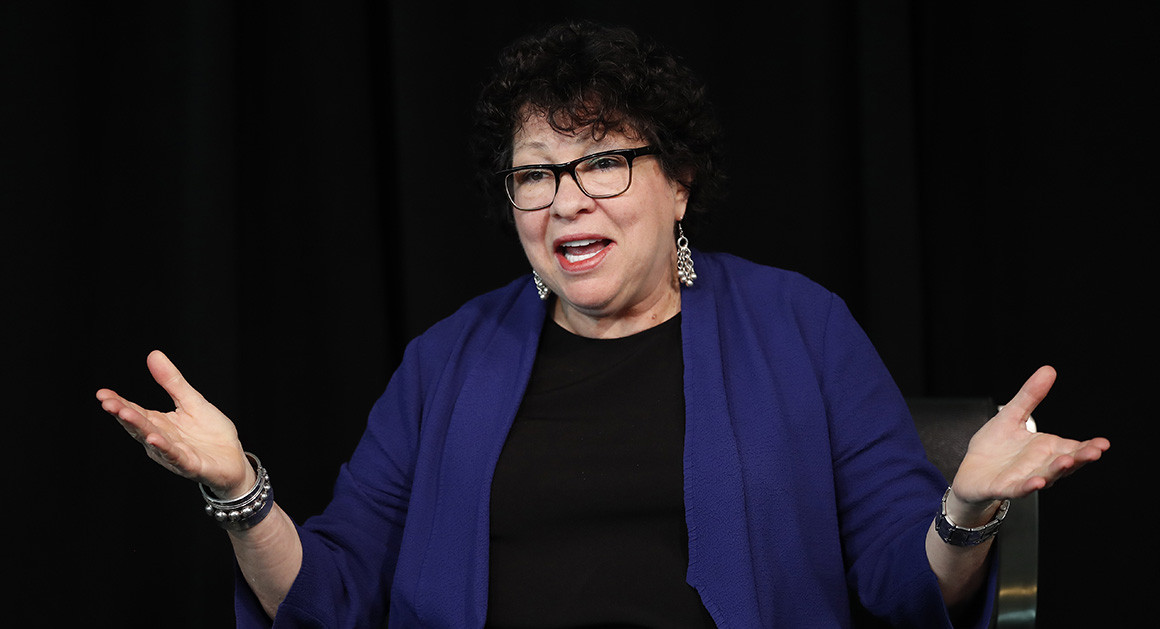If this was Trump, the media would have a myocardial infarction.
Sotomayor at work after health scare
By JOSH GERSTEIN and LORRAINE WOELLERT
01/19/2018 01:41 PM EST

Supreme Court Justice Sonia Sotomayor was diagnosed as a child with Type 1 diabetes, which she now controls through a combination of synthetic insulin injections, glucose tablets and regular checks of her blood sugar. | Carolyn Kaster/AP Photo
Paramedics were called to the Washington home of Justice Sonia Sotomayor Friday morning, but a Supreme Court spokeswoman said the justice was not hospitalized and went to work Friday after being treated for low blood sugar.
"She experienced symptoms of low blood sugar at her home this morning. She was treated by emergency medical services and is doing fine," court spokeswoman Kathy Arberg told POLITICO. "She's at work and following her usual schedule and will be participating in all planned activities over the weekend."
Story Continued Below
The episode caused concern to some neighbors of the 63-year-old justice, who lives in an apartment near Washington's Shaw and Columbia Heights neighborhoods.
Sotomayor was diagnosed as a child with Type 1 diabetes, which she now controls through a combination of synthetic insulin injections, glucose tablets and regular checks of her blood sugar.
When she was nominated to the high court by President Barack Obama, a doctor's statement said she practices so-called tight control of her blood sugar. The method can prolong the lives of those with diabetes and prevent serious complications, but risks low blood sugar levels.
"I'm super vigilant when I'm in court," she said in a 2013 interview with Diabetes Forecast magazine. "My most obvious sign, which I can't see, is paleness. If I start feeling any sort of lightness coming on, I immediately check."
Sotomayor also told the magazine that when her new law clerks arrive each fall, she describes to them the symptoms of a "sugar low" and how to treat them.
"You only have like a 15-minute lead time for the insulin to start working," she said. "If you're as controlled as I am, that 15 minutes is critical. You better start eating."
Sotomayor at work after health scare
By JOSH GERSTEIN and LORRAINE WOELLERT
01/19/2018 01:41 PM EST
Supreme Court Justice Sonia Sotomayor was diagnosed as a child with Type 1 diabetes, which she now controls through a combination of synthetic insulin injections, glucose tablets and regular checks of her blood sugar. | Carolyn Kaster/AP Photo
Paramedics were called to the Washington home of Justice Sonia Sotomayor Friday morning, but a Supreme Court spokeswoman said the justice was not hospitalized and went to work Friday after being treated for low blood sugar.
"She experienced symptoms of low blood sugar at her home this morning. She was treated by emergency medical services and is doing fine," court spokeswoman Kathy Arberg told POLITICO. "She's at work and following her usual schedule and will be participating in all planned activities over the weekend."
Story Continued Below
The episode caused concern to some neighbors of the 63-year-old justice, who lives in an apartment near Washington's Shaw and Columbia Heights neighborhoods.
Sotomayor was diagnosed as a child with Type 1 diabetes, which she now controls through a combination of synthetic insulin injections, glucose tablets and regular checks of her blood sugar.
When she was nominated to the high court by President Barack Obama, a doctor's statement said she practices so-called tight control of her blood sugar. The method can prolong the lives of those with diabetes and prevent serious complications, but risks low blood sugar levels.
"I'm super vigilant when I'm in court," she said in a 2013 interview with Diabetes Forecast magazine. "My most obvious sign, which I can't see, is paleness. If I start feeling any sort of lightness coming on, I immediately check."
Sotomayor also told the magazine that when her new law clerks arrive each fall, she describes to them the symptoms of a "sugar low" and how to treat them.
"You only have like a 15-minute lead time for the insulin to start working," she said. "If you're as controlled as I am, that 15 minutes is critical. You better start eating."










